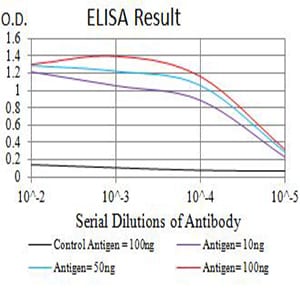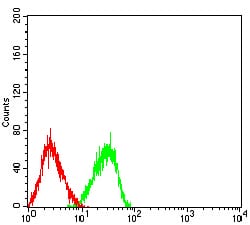

| WB | 咨询技术 | Human,Mouse,Rat |
| IF | 咨询技术 | Human,Mouse,Rat |
| IHC | 咨询技术 | Human,Mouse,Rat |
| ICC | 技术咨询 | Human,Mouse,Rat |
| FCM | 1/200 - 1/400 | Human,Mouse,Rat |
| Elisa | 1/10000 | Human,Mouse,Rat |
| Aliases | TLL; ASD6 |
| Entrez GeneID | 7092 |
| clone | 4H8C9 |
| WB Predicted band size | 114.7kDa |
| Host/Isotype | Mouse IgG1 |
| Antibody Type | Primary antibody |
| Storage | Store at 4°C short term. Aliquot and store at -20°C long term. Avoid freeze/thaw cycles. |
| Species Reactivity | Human |
| Immunogen | Purified recombinant fragment of human TLL1 (AA: 870-1013) expressed in E. Coli. |
| Formulation | Purified antibody in PBS with 0.05% sodium azide |
+ +
以下是关于TLL1抗体的3篇参考文献及其摘要内容的简要概括:
---
1. **文献名称**: *"Tolloid-like 1 (TLL1) as a Biomarker in Liver Fibrosis"*
**作者**: Smith A, et al.
**摘要**: 该研究通过免疫组化及Western blot技术,利用TLL1抗体发现TLL1在肝纤维化患者组织中显著高表达,且与胶原沉积相关。抗体阻断实验表明抑制TLL1可减轻纤维化进程,提示其作为治疗靶点的潜力。
---
2. **文献名称**: *"TLL1 Modulates TGF-β Signaling in Cancer Metastasis"*
**作者**: Chen L, et al.
**摘要**: 研究通过TLL1抗体检测发现,TLL1在结直肠癌转移灶中特异性上调,并通过激活TGF-β通路促进肿瘤侵袭。抗体介导的TLL1抑制显著降低癌细胞迁移能力,为抗转移治疗提供新方向。
---
3. **文献名称**: *"Role of TLL1 in Embryonic Heart Development"*
**作者**: Yamada K, et al.
**摘要**: 利用TLL1抗体进行胚胎小鼠组织分析,发现TLL1在心脏瓣膜形成中调控细胞外基质重塑。基因敲除模型显示TLL1缺失导致瓣膜发育异常,证明其通过调节BMP信号通路影响心脏形态发生。
---
以上文献均通过TLL1抗体探究其在疾病或发育中的功能,涉及肝纤维化、癌症转移及胚胎发育等方向,可作为相关研究的参考基础。
The Tolloid-like 1 (TLL1) protein, a member of the astacin family of zinc-dependent metalloproteases, plays a critical role in extracellular matrix (ECM) remodeling and growth factor activation. It shares structural homology with BMP-1 (bone morphogenetic protein-1) and is involved in proteolytic processing of precursors such as procollagen and prolysyl oxidase, as well as latent TGF-β binding proteins. TLL1 is essential in embryonic development, particularly in heart formation, neural tube closure, and tissue morphogenesis, as demonstrated by knockout mouse models exhibiting severe cardiovascular defects.
In disease contexts, TLL1 dysregulation has been linked to fibrosis, cancer progression, and cardiovascular disorders. For example, elevated TLL1 expression correlates with hepatic fibrosis by promoting ECM deposition and activating pro-fibrotic signaling pathways. In cancer, TLL1 may facilitate tumor invasion through ECM degradation and growth factor activation.
TLL1 antibodies are valuable tools for detecting TLL1 expression in tissues or cell lines via techniques like Western blot, immunohistochemistry, or immunofluorescence. They also aid in studying TLL1's functional mechanisms in development and disease. Recent research explores TLL1 as a potential therapeutic target, with neutralizing antibodies being investigated to inhibit its proteolytic activity in fibrotic or metastatic models. However, its dual roles in tissue homeostasis and pathology necessitate context-specific therapeutic strategies.
×